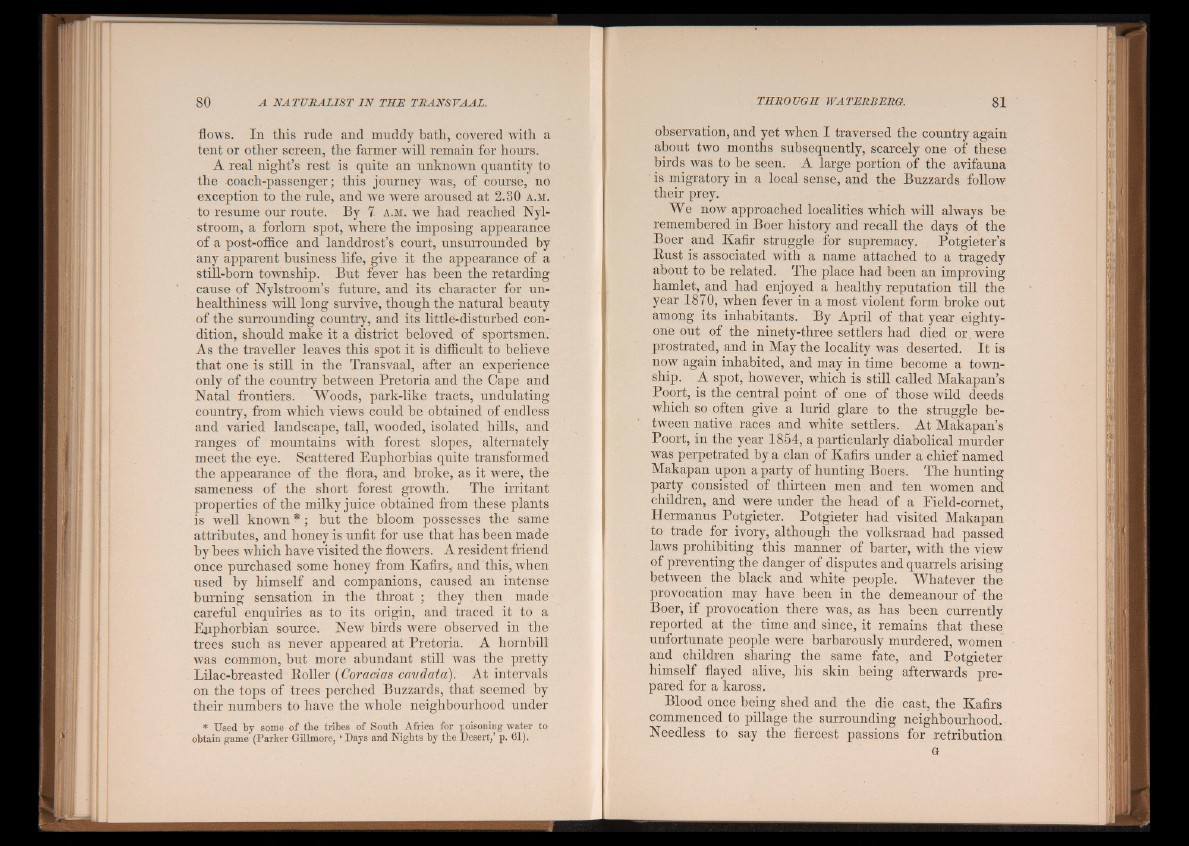
flows. In this rude and muddy bath, covered with a
tent or other screen, the farmer will remain for hours.
A real night’s rest is quite an unknown quantity to
the coach-passenger; this journey was, of course, no
exception to the rule, and we were aroused at 2.80 a .m .
to resume our route. By 7 a .m . we had reached Nyl-
stroom, a forlorn spot, where the imposing appearance
of a post-office and landdrost’s court, unsurrounded by
any apparent business life, give it the appearance of a
still-born township. But fever has been the retarding
cause of Nylstroom’s future, and its character for unhealthiness
will long survive, though the natural beauty
of the surrounding country, and its little-disturbed condition,
should make it a district beloved of sportsmen.
As the traveller leaves this spot it is difficult to believe
that one is still in the Transvaal, after an experience
only of the country between Pretoria and the Cape and
Natal frontiers. Woods, park-like tracts, undulating
country, from which views could be obtained of endless
and varied landscape, tall, wooded, isolated hills, and
ranges of mountains with forest slopes, alternately
meet the eye. Scattered Euphorbias quite transformed
the appearance of the flora, and broke, as it were, the
sameness of the short forest growth. The irritant
properties of the milky juice obtained from these plants
is well known *; hut the bloom possesses the same
attributes, and honey is unfit for use that has been made
by bees which have visited the flowers. A resident friend
once purchased some honey from Kafirs, and this, when
used by himself and companions, caused an intense
burning sensation in the throat ; they then made
careful enquiries as to its origin, and traced it to a
Ejiphorbian source. New birds were observed in the
trees such as never appeared at Pretoria. A hornbill
was common, but more abundant still was the pretty
Lilac-breasted Boiler (Coracias caudata). At intervals
on the tops of trees perched Buzzards, that seemed by
their numbers to have the whole neighbourhood under
* Used by some of the tribes of South Africa for poisoning water to
obtain game (Parker Gillmore, ‘ Days and Nights by the Desert,’ p. 61).
observation, and yet when I traversed the country again
about two months subsequently, scarcely one of these
birds was to be seen. A large portion of the avifauna
' is migratory in a local sense, and the Buzzards follow
their prey.
We now approached localities which will always be
remembered in Boer history and recall the days of the
Boer and Kafir struggle for supremacy, Potgieter’s
Bust is associated with a name attached to a tragedy
about to be related. The place had been an improving
hamlet, and had enjoyed a healthy reputation till the
year 1870, when fever in a most violent form broke out
among its inhabitants. By April of that year eighty-
one out of the ninety-three settlers had died or . were
prostrated, and in May the locality was deserted. It is
now again inhabited, and may in time become a township.
A spot, however, which is still called Makapan’s
Poort, is the central point of one of those wild deeds
which so often give a lurid glare to the struggle between
native races and white settlers. At Makapan’s
Poort, in the year 1854, a particularly diabolical murder
was perpetrated by a clan of Kafirs under a chief named
Makapan upon a party of hunting Boers. The hunting
party consisted of thirteen men. and ten women and
children, and were under the head of a Field-cornet,
Hermanus Potgieter. Potgieter had visited Makapan
to trade for ivory, although the volksraad had passed
laws prohibiting this manner of barter, with the view
of preventing the danger of disputes and quarrels arising
between the black and white people. Whatever the
provocation may have been in the demeanour of the
Boer, if provocation there was, as has been currently
reported at the time and since, it remains that these
unfortunate people were barbarously murdered, women
and children sharing the same fate, and Potgieter
himself flayed alive, his skin being afterwards prepared
for a kaross.
Blood once being shed and the die cast, the Kafirs
commenced to pillage the surrounding neighbourhood.
Needless to say the fiercest passions for retribution
G